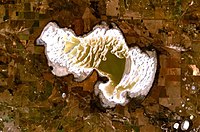
Photo from wikipedia
Abstract Aridity and salinity have a key role in driving physiological and ecological processes in desert ecosystems. However, how community‐scale foliar nutrients respond to aridity and salinity, and how these… Click to show full abstract
Abstract Aridity and salinity have a key role in driving physiological and ecological processes in desert ecosystems. However, how community‐scale foliar nutrients respond to aridity and salinity, and how these responses might vary with community composition along aridity and salinity gradients is unclear. We hypothesize that the response will be a shift in community stoichiometric values resulting from nutrient variability of shared species and unique species (site‐specific species), but little research has addressed the relative contribution of either component. We analyzed the community‐scale stoichiometric response of a desert community of perennial plants along an aridity and salinity transect by focusing on foliar nitrogen (N) and phosphorous (P) concentrations and N:P ratios. After evaluating the shared and unique species variability, we determined their relative contribution to the community stoichiometric response to aridity and salinity, reflected by changes in nonweighted and weighted community‐average values. Community‐scale stoichiometry decreased significantly under aridity and salinity, with significantly consistent changes in nonweighted and weighted community‐average stoichiometry for most shared and unique species measurements. The relative contribution of unique species shifts to the changes in community stoichiometry was greater (15%–77%) than the relative contribution of shared species shifts (7%–45%), excluding the change in weighted P concentration under aridity. Thus, the shifts of unique species amplified the community stoichiometric response to environmental changes. Synthesis. These results highlighted the need for a more in‐depth consideration of shared and unique species variability to understand and predict the effects of environmental change on the stoichiometry of plant communities. Although variation in community stoichiometry can be expected under extreme aridity and salinity conditions, changes of unique species could be a more important driver of the stoichiometric response of plant communities.
Journal Title: Ecology and Evolution
Year Published: 2020
Link to full text (if available)
Share on Social Media: Sign Up to like & get
recommendations!